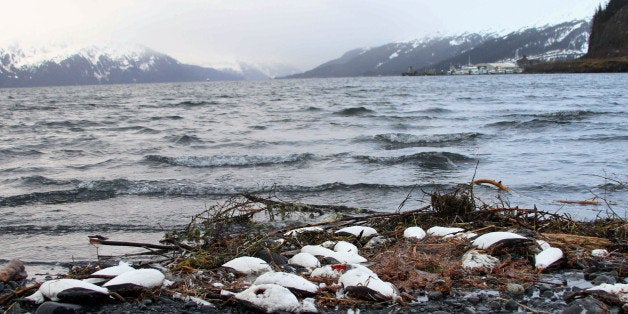
The Arctic is losing its cool. The polar jet stream wobbles and dips bringing frigid temperatures to lower latitudes but leaving the Arctic to thaw. On Greenland, 8,300 tons of ice melt every second changing the gravitational pull of the Earth. Arctic Ocean sea ice is dissolving.
In Alaska, temperatures this winter have been 14 degrees above normal, the second warmest winter on record after the winter of 2000-01. In Anchorage, this has meant that winter temperatures are consistently soaring above 40 degrees. February 2016 was the warmest ever recorded.
This year's winter temperatures are not an anomaly but becoming part of a pattern. In January 2014, temperatures hovered between 40-50 degrees for two weeks. North of the Arctic Circle, in Nome, temperatures also rose to 50 degrees. During February 2015, our local newspaper proclaimed a heat wave because temperatures were consistently in the mid-40s.
Without the cold, there has been very little snow in Alaska. Rain ushered in the New Year for the second consecutive year in Anchorage. Only 3.5 inches of snow blanketed the city in January, significantly below the average of 11.3 inches. Between January 15 and February 20, no snow fell, breaking a 60 year-old record of having the most consecutive days without snow falling. The snow which fell on February 21, 1.8 inches, was bookended by rain and quickly disappeared.
The Chugach Mountains look naked. Wolverine, Temptation, Williwaw -- these are the names of the mountains that rise more than 3,000 feet from Anchorage's coastal plain. All winter, they have been speckled brown and white without their normal snow blanket. The mountain grasses and low-lying bushes exposed. Skiing has been impossible.
Anchorage is not alone in its snow despair. For the first time since 1942, Juneau, located in southeast Alaska, had no measurable snowfall during January. The average is 27.3 inches. In Fairbanks, just 200 miles south of the Arctic Circle, January 2016 was the second lowest snowfall recorded - less than an inch of snow fell the entire month. The average January snowfall in Fairbanks is 10.3 inches. Despondent, Alaskans write love letters to snow. We are terrified that these winters, which flip flop between rain and snow, are our new normal.
The reasons for consecutive snowless winters multiply with no definitive answer, except the undeniable record-breaking increase in temperature. 2015 was the warmest year on record. Some scientists speculate that the loss of Arctic Ocean sea ice is causing the snow to disappear.
Record minimum levels of sea ice have been documented during the summer months since 2002. But this year, in both January and February when the sea ice is supposed to be increasing to reach its maximum extent in March, sea ice extent marked record lows. In the middle of February, the growth of the sea ice stalled for two weeks.
Others attribute Alaska's loss of snow to El Nino and others point to the blob, the warm ocean water that has been clinging to the Alaska coast since at least September 2014 and has recently started to dissipate. Not since records began has the North Pacific Ocean been so warm for so long, with sea surface temperatures as much as 3 degrees C (about 5.4 degrees F) higher than average, and stretching for many hundreds of miles.
In our arrogance, we think that technology will be able to suck carbon out of the atmosphere and design sea walls tall enough to create fortresses along the coast. For the 62 people who own as much wealth as 3.5 billion people, they may be able to protect themselves from the ecological unraveling of our planet, but what kind of a planet will they live on?
Some have called this era the sixth mass extinction. Plants and animals are not able to make the rapid adjustment to our radical transformation of the web of life. In Alaska, thousands of sea birds, murres, have died in the last few months -- the largest die off ever recorded. They are not the only species suffering.
The recently negotiated Paris Climate Agreement includes aspirational language to limit the global temperature increase to 1.5 degrees Celsius (2.7 Fahrenheit). But in Alaska, winter temperatures have already far surpassed this goal. The recent accord between Canada and the United States to reduce carbon emissions is welcome, but not enough to halt this acceleration of Earth system change.
We cannot wait for world leaders to drastically reduce carbon emissions. We must demand that the Earth's ecosystems be protected now and that those least responsible for our climate crisis be provided the resources to adapt and protect their lives. Divest, protest and stop using motorized transportation.
The power for change rests with each of us. And in this way, we can demonstrate our solidarity with all living beings who dwell upon this precious home. We are the first responders.